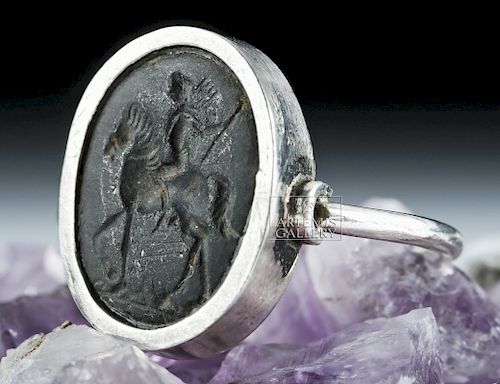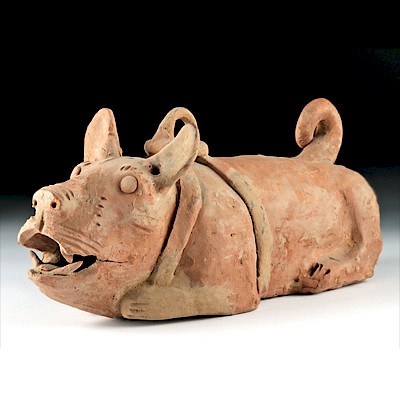Roman Silver Ring w/ Onyx Intaglio - Alexander
Lot 28
About Seller
Artemis Fine Arts
686 S Taylor Ave, Ste 106
Louisville, CO 80027
United States
Selling antiquities, ancient and ethnographic art online since 1993, Artemis Gallery specializes in Classical Antiquities (Egyptian, Greek, Roman, Near Eastern), Asian, Pre-Columbian, African / Tribal / Oceanographic art. Our extensive inventory includes pottery, stone, metal, wood, glass and textil...Read more
Estimate:
$800 - $1,200
Absentee vs Live bid
Two ways to bid:
- Leave a max absentee bid and the platform will bid on your behalf up to your maximum bid during the live auction.
- Bid live during the auction and your bids will be submitted real-time to the auctioneer.
Bid Increments
| Price | Bid Increment |
|---|---|
| $0 | $25 |
| $300 | $50 |
| $1,000 | $100 |
| $2,000 | $250 |
| $5,000 | $500 |
| $10,000 | $1,000 |
| $20,000 | $2,500 |
| $50,000 | $5,000 |
| $100,000 | $10,000 |
| $200,000 | $20,000 |
About Auction
By Artemis Fine Arts
Sep 13, 2018
Set Reminder
2018-09-13 10:00:00
2018-09-13 10:00:00
America/New_York
Bidsquare
Bidsquare : Ancient | Asian | Ethnographic - Fall Variety
https://www.bidsquare.com/auctions/artemis-gallery/ancient-asian-ethnographic---fall-variety-3432
Travel the world and back in time... Antiquities from Egypt, Greece, Italy and the Near East, Asian, Pre-Columbian, African / Tribal / Oceanic, Native American, Spanish Colonial, Russian Icons, Fine Art, much more! Artemis Fine Arts info@artemisfinearts.com
Travel the world and back in time... Antiquities from Egypt, Greece, Italy and the Near East, Asian, Pre-Columbian, African / Tribal / Oceanic, Native American, Spanish Colonial, Russian Icons, Fine Art, much more! Artemis Fine Arts info@artemisfinearts.com
- Lot Description
Roman, Imperial Period, ca. 1st to 3rd century CE. An attractive silver ring set with a large oval, black onyx intaglio incised with an image of Alexander the Great riding Bucephalus! The mighty steed belonging to Alexander the Great was bravely tamed by the young prince before a skeptical audience to prove his might (see extended description below for this entertaining legend). The powerful horse, reportedly much larger than most Macedonian horses of the time, is depicted in motion; note the dynamic positioning of the legs (front leg rearing up). Only Alexander could ride the wild Bucephalus and the two were inseparable, working together in every battle, until Bucephalus was kidnapped following his final defeat of Darius, while Alexander was on an excursion. With this news Alexander boldly declared that he would destroy the countryside - fell every tree and kill every inhabitant, a threat that resulted in the return of his horse and the guilty party begging forgiveness. Size: intaglio measures .75" L x .625" W (1.9 cm x 1.6 cm); US ring size 7.625; setting is 95% silver
Bucephalus was Alexander the Great's valiant stallion, regarded as the most famous horse throughout history. The story of their pairing is quite marvelous. Bucephalus was first brought to Macedonia and presented to Alexander's father, King Phillip II, in 346 BCE by Philoneicus of Thessaly. The magnificent horse was much taller than the typical Macedonian bronco; however, he appeared to be way too unruly and wild. So Phillip ordered that he be taken away. Young Alexander was watching from the audience with his mother Olympias. He stood up, called the attendants weak, and according to Plutarch's biography, the handsome prince said, "What an excellent horse do they lose for want of address and boldness to manage him." Phillip responded, "Do you reproach those who are older than yourself, as if you were better able to manage him than they?" Alexander then declared that he would pay for the horse if he could not tame the noble steed. Alexander, ignoring the uproarious laughter of the crowd, approached the horse calmly, for he had recognized something that no one else apparently had; the horse was simply afraid of his own shadow. So Alexander wisely turned the horse toward the sun, so that his shadow as behind him, took the reigns, mounted him, and rode off. When Alexander returned to the arena and dismounted, Phillip said, according to Plutarch, "O my son look thee out a kingdom equal to and worthy of thyself, for Macedonia is too little for thee." In short, this seemingly miraculous taming of the wild Bucephalus signified a turning point and demonstrated that Alexander would be the mighty conqueror of most of the known world of his day.
Provenance: private San Francisco, California, USA collection
All items legal to buy/sell under U.S. Statute covering cultural patrimony Code 2600, CHAPTER 14, and are guaranteed to be as described or your money back.
A Certificate of Authenticity will accompany all winning bids.
We ship worldwide and handle all shipping in-house for your convenience.
#135207Minor scratches and earthen deposits on the intaglio, but the incised imagery is still vivid. Slight scratches and wear to the silver shank.Condition
- Shipping Info
-
All shipping is handled in-house for your convenience. Your invoice from Artemis Gallery will include shipping calculation instructions. If in doubt, please inquire BEFORE bidding for estimated shipping costs for individual items.
-
- Buyer's Premium



 EUR
EUR CAD
CAD AUD
AUD GBP
GBP MXN
MXN HKD
HKD CNY
CNY MYR
MYR SEK
SEK SGD
SGD CHF
CHF THB
THB














